Experimental and Numerical Analysis of Fatigue Life of Aluminum Al 2024-T351 at Elevated Temperature
Abstract
1. Introduction
2. Methodology
2.1. Experimental Procedures
2.2. Numerical Procedures
3. Results and Discussion
3.1. Fatigue Life of Aluminium Al 2024-T351
3.2. Numerical Results
4. Conclusions
Author Contributions
Funding
Conflicts of Interest
References
- Heinz, A.; Haszler, A.; Keidel, C.; Moldenhauer, S.; Benedictus, R.; Miller, W. Recent development in aluminium alloys for aerospace applications. Mater. Sci. Eng. A 2000, 280, 102–107. [Google Scholar] [CrossRef]
- Dursun, T.; Soutis, C. Recent developments in advanced aircraft aluminium alloys. Mater. Des. 2014, 56, 862–871. [Google Scholar] [CrossRef]
- Wachowski, M.; Sniezek, L.; Szachogluchowicz, I.; Kosturek, R.; Płociński, T. Microstructure and Fatigue life of Cp-Ti/316L Bimetallic Joints Obtained by Means of Explosive Welding. Bull. Pol. Acad. Sci. Tech. Sci. 2018, 66, 925–933. [Google Scholar]
- Badaruddin, M.; Zulhanif; Supriadi, H. Low Cycle Fatigue Properties of Extruded 6061-T6 Aluminum Alloy. J. Phys. Conf. Ser. 2019, 1198, 032002. [Google Scholar] [CrossRef]
- Zhao, X.; Li, H.; Chen, T.; Cao, B.; Li, X. Mechanical Properties of Aluminum Alloys under Low-Cycle Fatigue Loading. Materials 2019, 12, 2064. [Google Scholar] [CrossRef] [PubMed]
- Kurek, A.; Kurek, M.; Łagoda, T. Stress-life curve for high and low cycle fatigue. J. Theor. Appl. Mech. 2019, 57, 677–684. [Google Scholar] [CrossRef]
- Pereira, A.B.; Fernandes, F.A.; De Morais, A.; Carvalhoso, P.; Morais, D. Development of a Delamination Fatigue Testing Machine for Composite Materials. Machines 2019, 7, 27. [Google Scholar] [CrossRef]
- Ai, Y.; Zhu, S.-P.; Liao, D.; Correia, J.A.; De Jesus, A.M.; Keshtegar, B. Probabilistic modelling of notch fatigue and size effect of components using highly stressed volume approach. Int. J. Fatigue 2019, 127, 110–119. [Google Scholar] [CrossRef]
- Ohnistova, P.; Piska, M.; Petrenec, M.; Dluhos, J.; Hornikova, J.; Šandera, P. Fatigue Life of 7475-T7351 Aluminum After Local Severe Plastic Deformation Caused by Machining. Materials 2019, 12, 3605. [Google Scholar] [CrossRef]
- Zhang, J.; Fu, X.; Lin, J.; Liu, Z.; Liu, N.; Wu, B. Study on Damage Accumulation and Life Prediction with Loads below Fatigue Limit Based on a Modified Nonlinear Model. Materials 2018, 11, 2298. [Google Scholar] [CrossRef]
- Yu, Z.-Y.; Zhu, S.-P.; Liu, Q.; Liu, Y. Multiaxial Fatigue Damage Parameter and Life Prediction without Any Additional Material Constants. Materials 2017, 10, 923. [Google Scholar] [CrossRef] [PubMed]
- Xue, L.; Shang, D.-G.; Li, L.J. Online fatigue damage evaluation method based on real-time cycle counting under multiaxial variable amplitude loading. IOP Conf. Ser. Mater. Sci. Eng. 2020, 784, 012014. [Google Scholar] [CrossRef]
- Zhu, S.-P.; Yue, P.; Yu, Z.-Y.; Wang, Q. A Combined High and Low Cycle Fatigue Model for Life Prediction of Turbine Blades. Materials 2017, 10, 698. [Google Scholar] [CrossRef] [PubMed]
- Rozumek, D.; Faszynka, S. Surface cracks growth in aluminum alloy AW-2017A-T4 under combined loadings. Eng. Fract. Mech. 2020, 226, 106896. [Google Scholar] [CrossRef]
- Pec, M.; Zapletal, J.; Šebek, F.; Petruska, J. Low-Cycle Fatigue, Fractography and Life Assessment of EN AW 2024-T351 under Various Loadings. Exp. Tech. 2018, 43, 41–56. [Google Scholar] [CrossRef]
- ASTM E739-80. Standard practice for statistical analysis of linearized stress-life (S-N) and strain-life (E-N) fatigue data. In Annual Book of ASTM Standards; ASTM International: Philadelphia, PA, USA, 1989; Volume 32, pp. 667–673. [Google Scholar]
- ASTM E8/E8M. ASTM E8/E8M Standard Test Methods for Tension Testing of Metallic Materials; ASTM International: West Conshohocken, PA, USA, 2010; Volume 1, pp. 1–27. [Google Scholar] [CrossRef]
- ASTM E466-15. American Society for Testing and Materials. In Practice for Conducting Force Controlled Constant Amplitude Axial Fatigue Tests of Metallic Materials; ASTM: West Conshohocken, PA, USA, 2015; pp. 1–6. [Google Scholar] [CrossRef]
- Hockauf, M.; Wagner, M.-X.; Halle, T.; Niendorf, T.; Lampke, T. Influence of precipitates on low-cycle fatigue and crack growth behavior in an ultrafine-grained aluminum alloy. Acta Mater. 2014, 80, 250–263. [Google Scholar] [CrossRef]
- DelBove, M.; Vogt, J.-B.; Bouquerel, J.; Soreau, T.; François, N.; Primaux, F. Microstructure Evolution of a Precipitation Hardened Cu-Ni-Si Alloy during Low Cycle Fatigue. Solid State Phenom. 2016, 258, 546–549. [Google Scholar] [CrossRef]
- Ziaja, W.; Motyka, M.; Dybiec, H.; Sieniawski, J. High cycle bending fatigue life of submicrocrystalline aluminum alloy. Mech. Mater. 2013, 67, 33–37. [Google Scholar] [CrossRef]
- Takahashi, Y.; Shikama, T.; Yoshihara, S.; Aiura, T.; Noguchi, H. Study on dominant mechanism of high-cycle fatigue life in 6061-T6 aluminum alloy through microanalyses of microstructurally small cracks. Acta Mater. 2012, 60, 2554–2567. [Google Scholar] [CrossRef]
- Rozumek, D.; Marciniak, Z. Fatigue crack growth in AlCu4Mg1 under nonproportional bending-with-torsion loading. Mater. Sci. 2011, 46, 685–694. [Google Scholar] [CrossRef]
- Chakherlou, T.; Aghdam, A.; Akbari, A.; Saeedi, K. Analysis of cold expanded fastener holes subjected to short time creep: Finite element modelling and fatigue tests. Mater. Des. 2010, 31, 2858–2866. [Google Scholar] [CrossRef]
- Mannan, S.; Valsan, M. High-temperature low cycle fatigue, creep–fatigue and thermomechanical fatigue of steels and their welds. Int. J. Mech. Sci. 2006, 48, 160–175. [Google Scholar] [CrossRef]
- Szusta, J.; Seweryn, A. Experimental study of the low-cycle fatigue life under multiaxial loading of aluminum alloy EN AW-2024-T3 at elevated temperatures. Int. J. Fatigue 2017, 96, 28–42. [Google Scholar] [CrossRef]
- Lee, Y.-L.; Taylor, D. Stress-Based Fatigue Analysis and Design. Fatigue Test. Anal. 2005, 103–180. [Google Scholar] [CrossRef]
- Karakaş, Ö.; Szusta, J. Monotonic and low cycle fatigue behaviour of 2024-T3 aluminium alloy between room temperature and 300 °C for designing VAWT components. Fatigue Fract. Eng. Mater. Struct. 2015, 39, 95–109. [Google Scholar] [CrossRef]
- Lee, K.-O.; Bae, K.-H.; Lee, S.-B. Comparison of prediction methods for low-cycle fatigue life of HIP superalloys at elevated temperatures for turbopump reliability. Mater. Sci. Eng. A 2009, 519, 112–120. [Google Scholar] [CrossRef]
- Li, H.; Nishimura, A.; Nagasaka, T.; Muroga, T. Stress–strain behavior on tensile and low cycle fatigue tests of JLF-1 steel at elevated temperature in vacuum. Fusion Eng. Des. 2006, 81, 2907–2912. [Google Scholar] [CrossRef]
- Nagode, M. An online algorithm for temperature influenced fatigue–life estimation: Strain–life approach. Int. J. Fatigue 2004, 26, 155–161. [Google Scholar] [CrossRef]
- Weiss, M.P.; Lavi, E. Fatigue of metals—What the designer needs? Int. J. Fatigue 2016, 84, 80–90. [Google Scholar] [CrossRef]
- Uematsu, Y.; Akita, M.; Nakajima, M.; Tokaji, K. Effect of temperature on high cycle fatigue behaviour in 18Cr–2Mo ferritic stainless steel. Int. J. Fatigue 2008, 30, 642–648. [Google Scholar] [CrossRef]
- Gurubaran, P.; Afendi, M.; Fareisha, M.A.N.; Majid, M.A.; Haftirman, I.; A Rahman, M.T. Fatigue life investigation of UIC 54 rail profile for high speed rail. J. Phys. Conf. Ser. 2017, 908, 12026. [Google Scholar] [CrossRef]
- Ergenc, A.F.; Ergenc, A.T.; Kale, S.; Sahin, I.G.; Dagdelen, K.; Pestelli, V.; Yontem, O.; Kuday, B. Reduced Weight Automotive Brake Pedal Test & Analysis. Int. J. Automot. Sci. Technol. 2017, 1, 8–13. [Google Scholar]
- Singh, P.K.; Gautam, M.G.; Lal, S.B. Stress Analysis Spur Gear Design by Using Ansys Workbench. Int. J. Mech. Eng. Robot. Res. 2014, 3, 64–68. [Google Scholar]
- Adigio, E.M.; Nangi, E.O. Computer Aided Design and Simulation of Radial Fatigue Test of Automobile Rim Using ANSYS. IOSR J. Mech. Civ. Eng. 2014, 11, 68–73. [Google Scholar] [CrossRef]
- Lesiuk, G.; Szata, M.; Rozumek, D.; Marciniak, Z.; Correia, J.; De Jesus, A. Energy response of S355 and 41Cr4 steel during fatigue crack growth process. J. Strain Anal. Eng. Des. 2018, 53, 663–675. [Google Scholar] [CrossRef]
- Jain, N. The reduction of stress concentration in a uni-axially loaded infinite width rectangular isotropic/orthotropic plate with central circular hole by coaxial auxiliary holes. IIUM Eng. J. 2012, 12. [Google Scholar] [CrossRef]
- Jain, N.; Banerjee, M.; Sanyal, S. Three Dimensional Parametric Analyses on Effect of Fibre Orientation for Stress Concentration Factor in Fibrous Composite Cantilever Plate with Central Circular Hole under Transverse Loading. IIUM Eng. J. 2012, 13. [Google Scholar] [CrossRef]
- Fuchs, H.O.; Stephens, R.I.; Saunders, H. Metal Fatigue in Engineering; Wiley: New York, NY, USA, 2001. [Google Scholar]
- Lipski, A.; Mroziński, S. The Effects of Temperature on the Strength Properties of Aluminium Alloy 2024-T3. Acta Mech. Autom. 2012, 6, 62–66. [Google Scholar]
- Khan, S.; Kintzel, O.; Mosler, J. Experimental and numerical lifetime assessment of Al 2024 sheet. Int. J. Fatigue 2012, 37, 112–122. [Google Scholar] [CrossRef]
- Tomczyk, A.; Seweryn, A. Fatigue life of EN AW-2024 alloy accounting for creep pre-deformation at elevated temperature. Int. J. Fatigue 2017, 103, 488–507. [Google Scholar] [CrossRef]
- Man, J.; Obrtlík, K.; Polak, J. Study of surface relief evolution in fatigued 316L austenitic stainless steel by AFM. Mater. Sci. Eng. A 2003, 351, 123–132. [Google Scholar] [CrossRef]
- Cao, X.; Xu, L.; Xu, X.-L.; Wang, Q. Fatigue Fracture Characteristics of Ti6Al4V Subjected to Ultrasonic Nanocrystal Surface Modification. Metals 2018, 8, 77. [Google Scholar] [CrossRef]
- Khan, S.; Vyshnevskyy, A.; Mosler, J. Low cycle lifetime assessment of Al2024 alloy. Int. J. Fatigue 2010, 32, 1270–1277. [Google Scholar] [CrossRef]
- Wisner, B.; Kontsos, A. Investigation of particle fracture during fatigue of aluminum 2024. Int. J. Fatigue 2018, 111, 33–43. [Google Scholar] [CrossRef]
- Caton, M.; John, R.; Porter, W.; Burba, M. Stress ratio effects on small fatigue crack growth in Ti–6Al–4V. Int. J. Fatigue 2012, 38, 36–45. [Google Scholar] [CrossRef]
- François, D. The Influence of the Microstructure on Fatigue. Adv. Fatigue Sci. Technol. 1989, 23–76. [Google Scholar] [CrossRef]
- Hussain, F.; Abdullah, S.; Nuawi, M. Effect of temperature on fatigue life behaviour of aluminium alloy AA6061 using analytical approach. J. Mech. Eng. Sci. 2016, 10, 2324–2335. [Google Scholar] [CrossRef]
- Marno, M.; Ismail, A.F.; Marini, B.A. Torsional Deformation and Fatigue Behaviour of 6061 Aluminium Alloy. IIUM Eng. J. 2012, 12. [Google Scholar] [CrossRef]
- Zakaria, K.; Abdullah, S.; Ghazali, M.J. Comparative study of fatigue life behaviour of AA6061 and AA7075 alloys under spectrum loadings. Mater. Des. 2013, 49, 48–57. [Google Scholar] [CrossRef]
- Liu, Y.; Yu, J.; Xu, Y.; Sun, Y.; Guan, H.; Hu, Z. High cycle fatigue behavior of a single crystal superalloy at elevated temperatures. Mater. Sci. Eng. A 2007, 454, 357–366. [Google Scholar] [CrossRef]
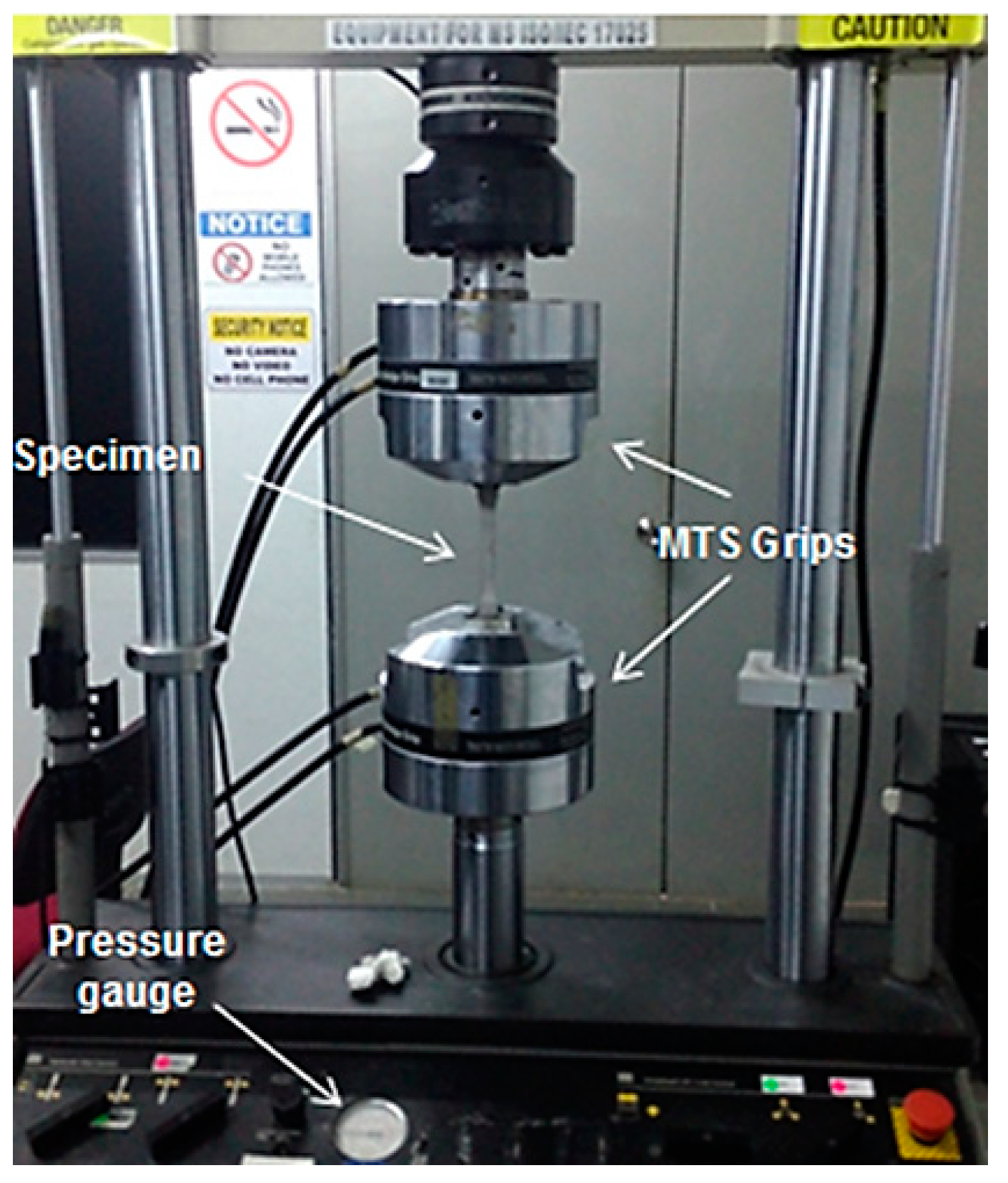
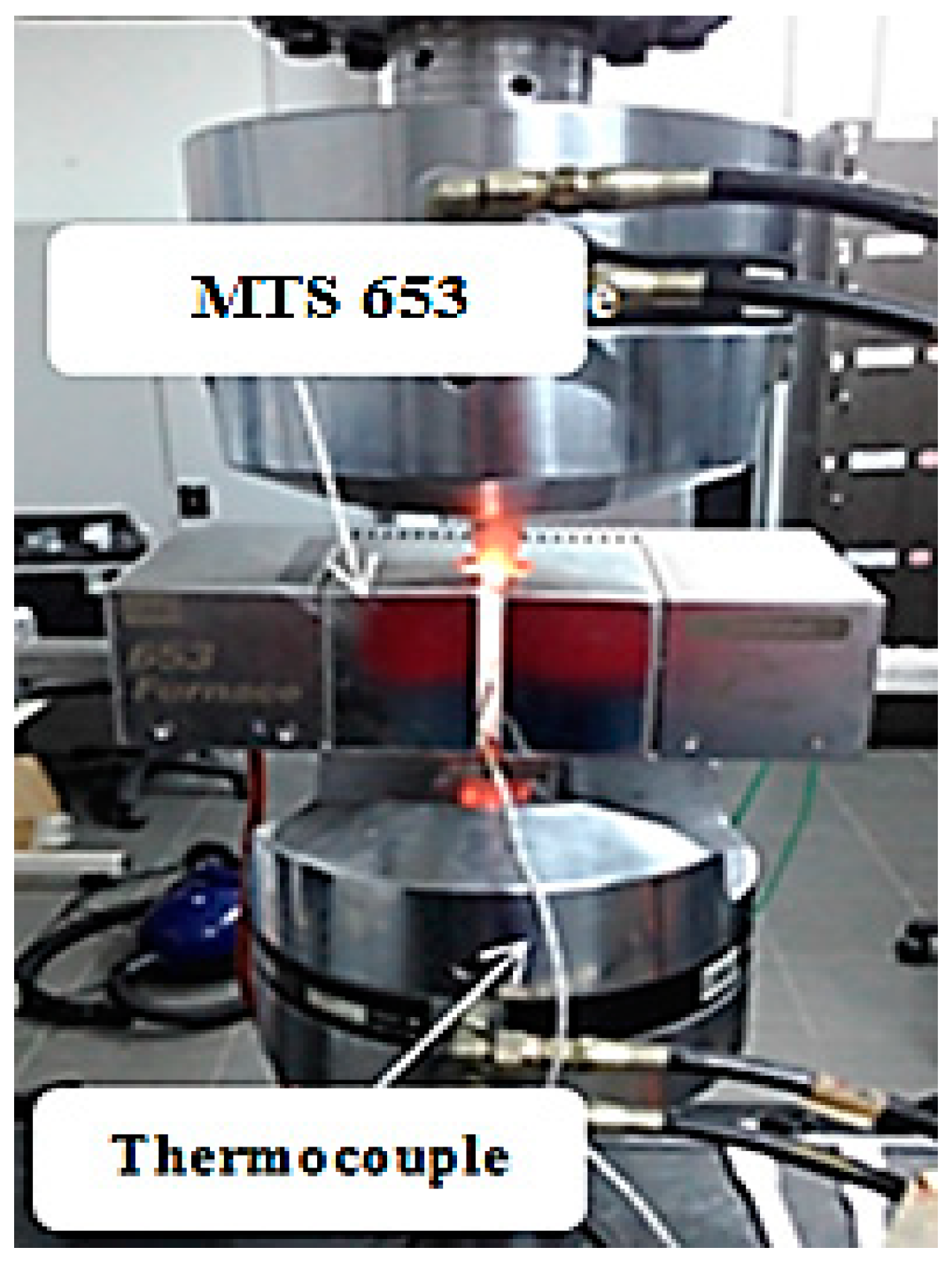
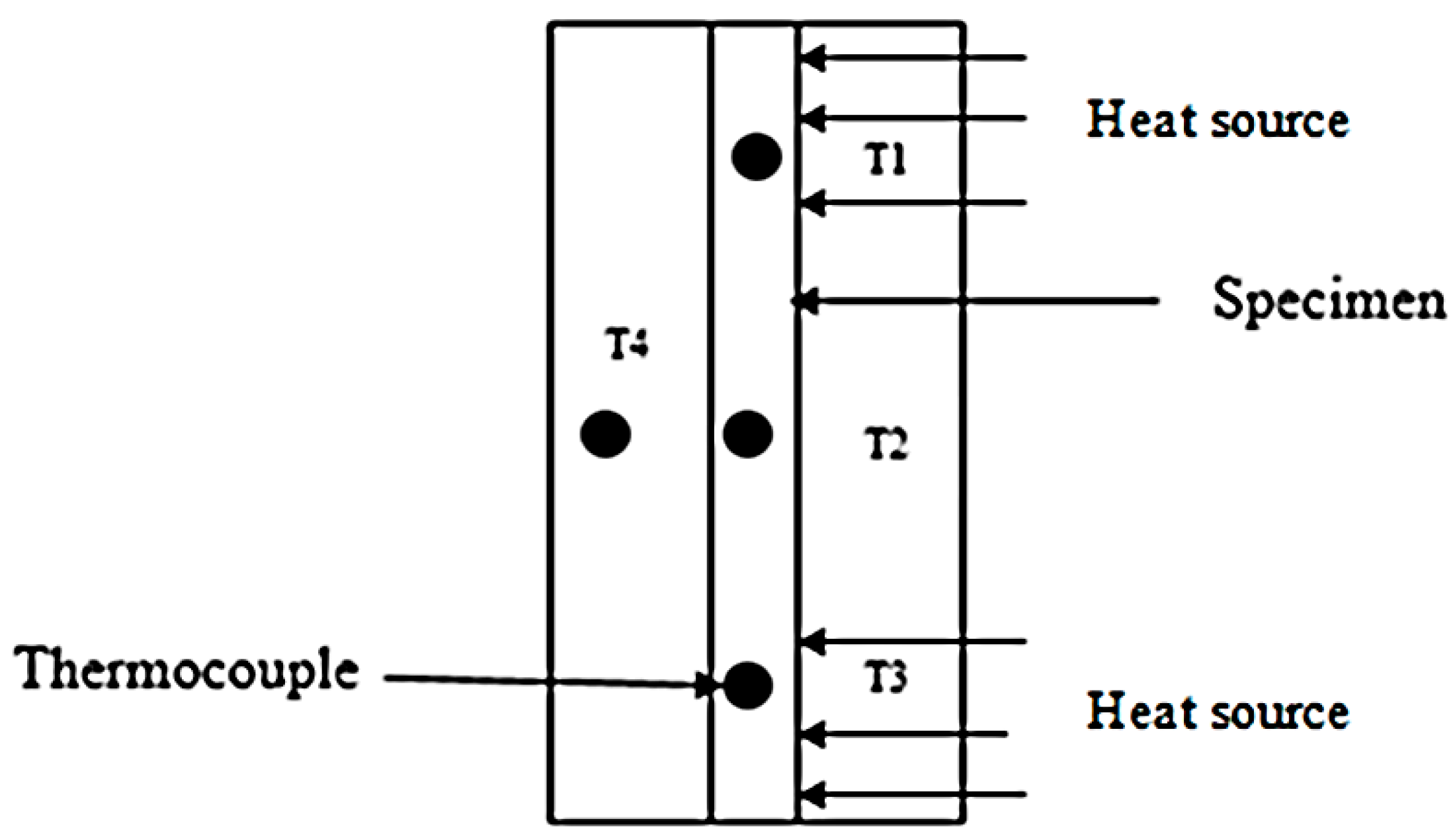
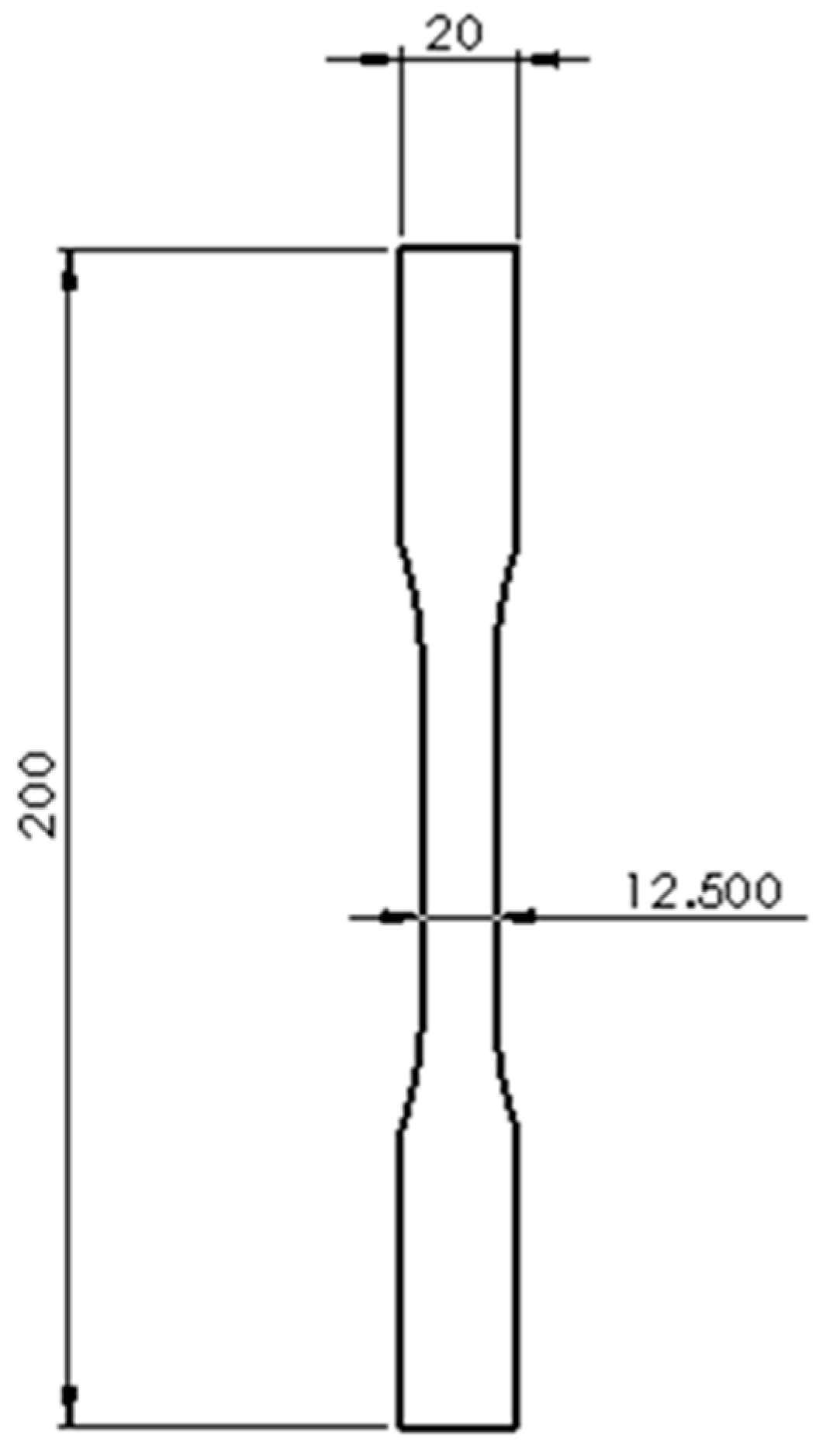

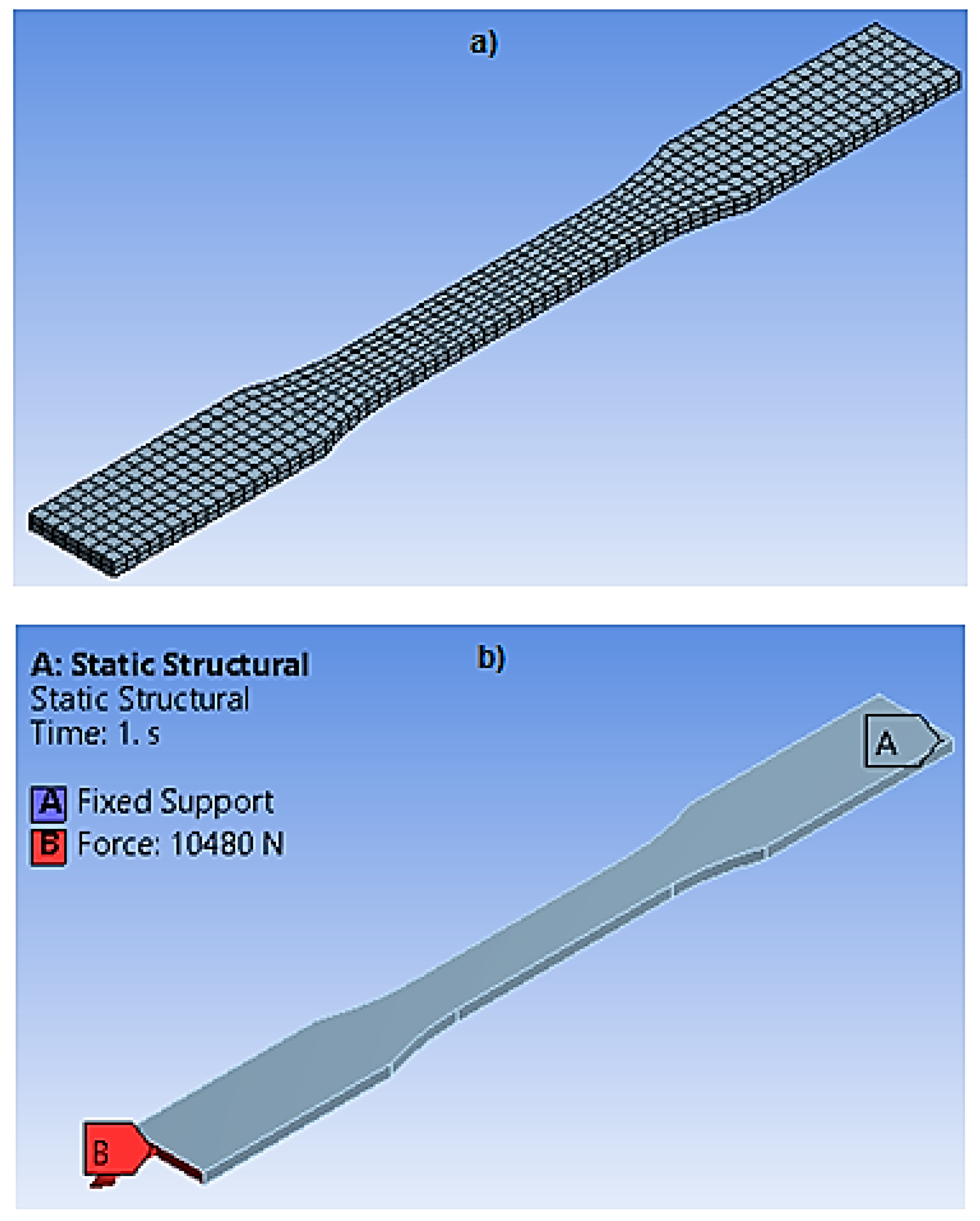
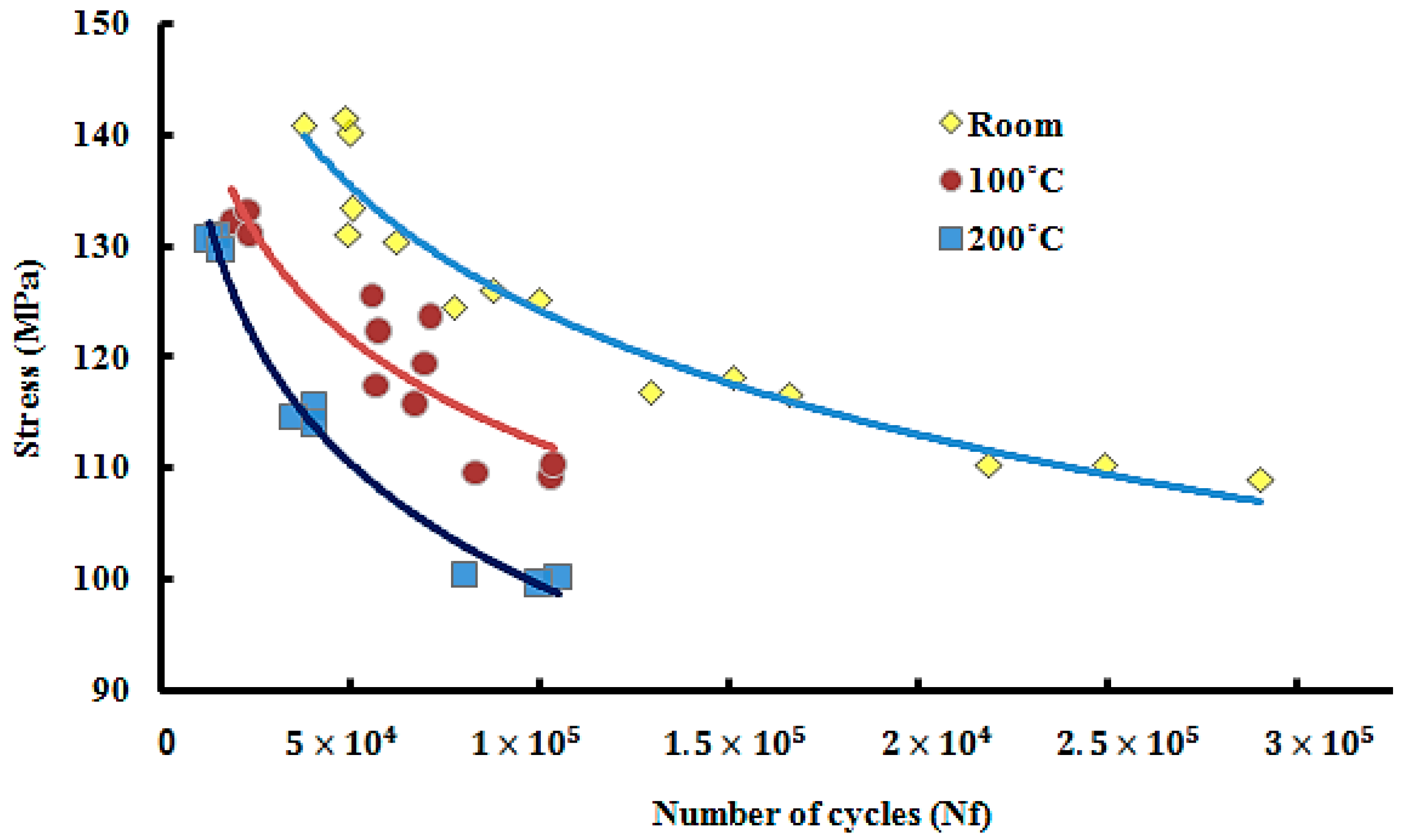




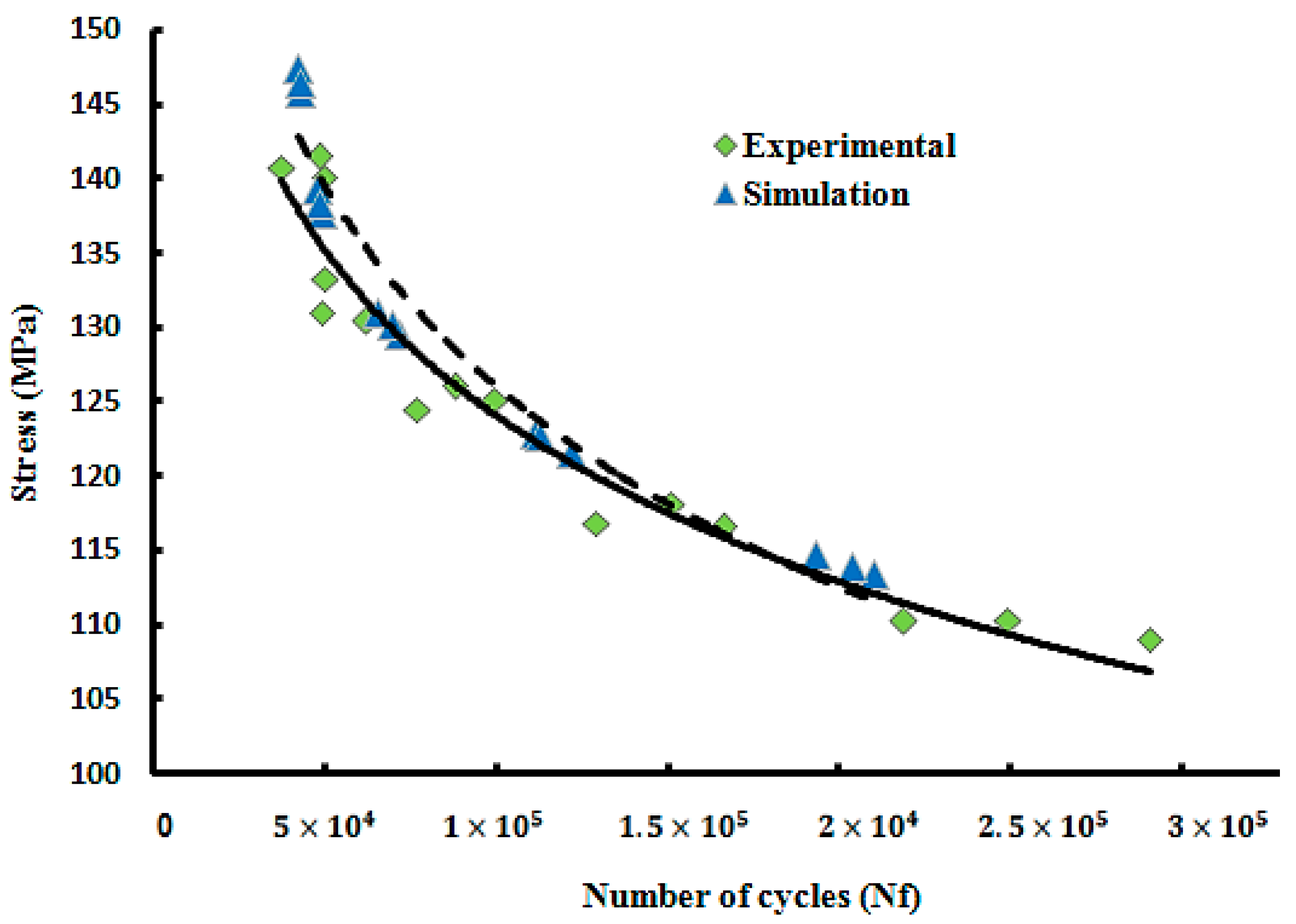
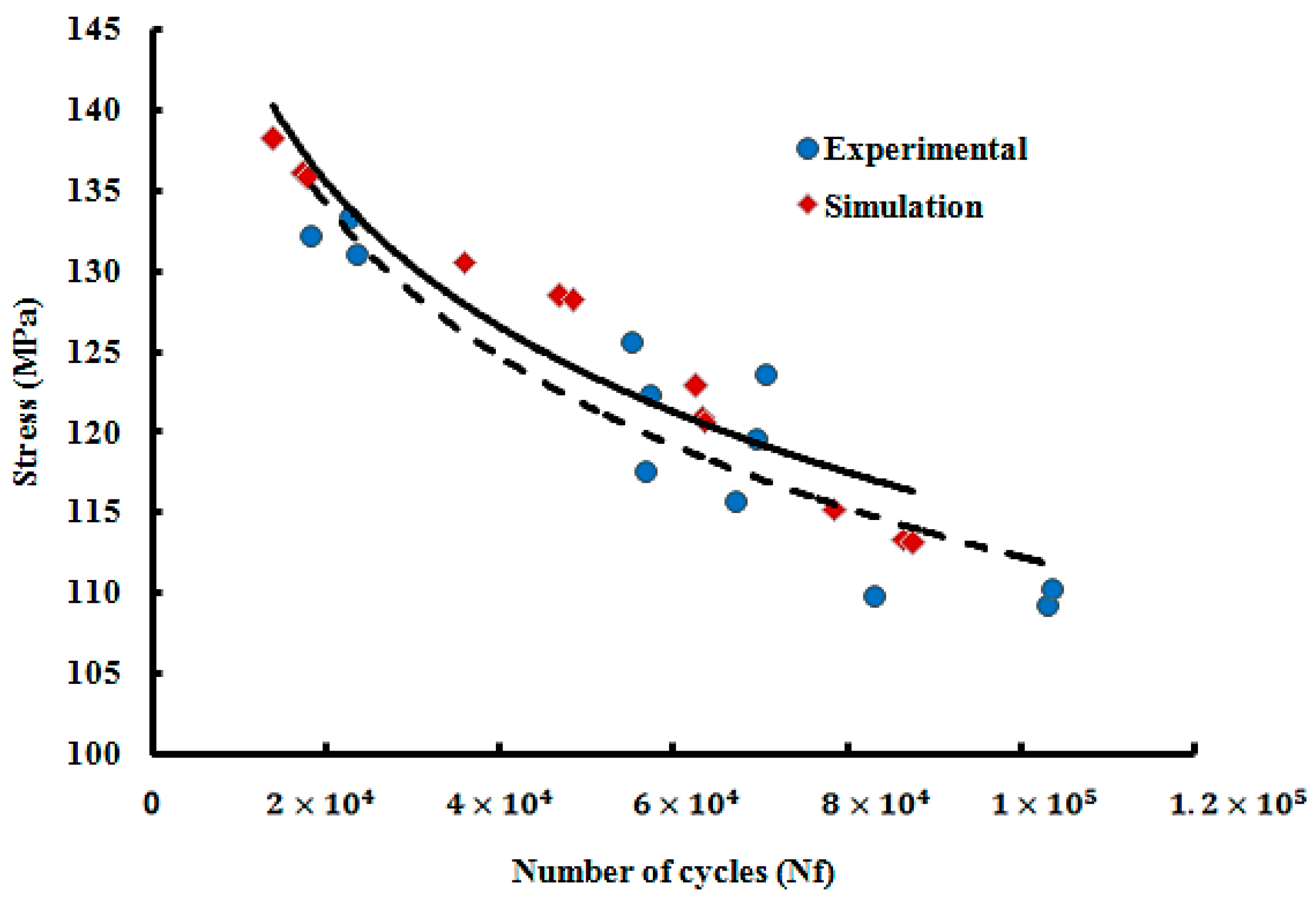
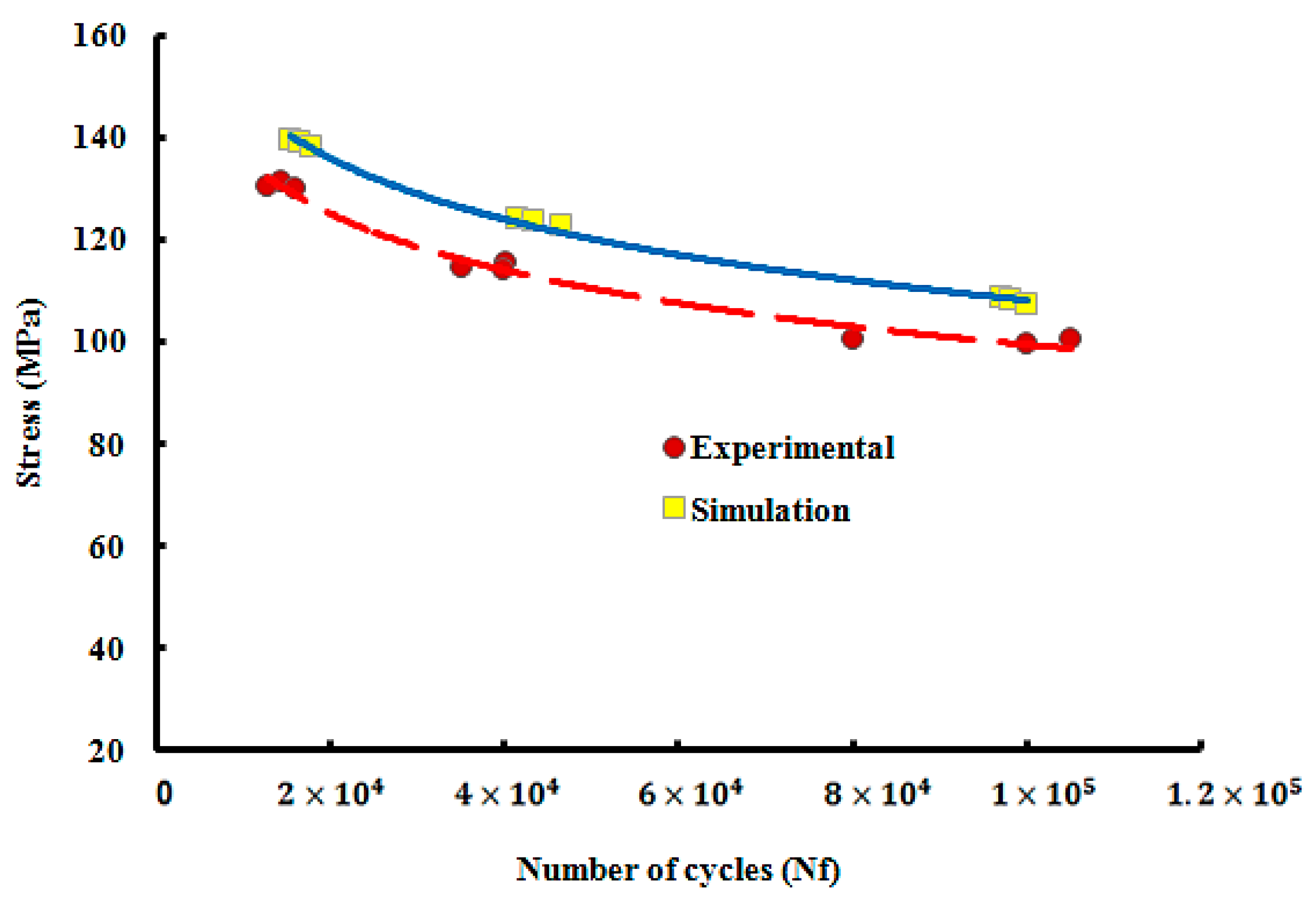
| Condition | Yield Strength (%) | Mean Load (kN) | Amplitude (kN) |
|---|---|---|---|
| Room | 90 | 6.48 | 5.31 |
| 85 | 6.13 | 5.01 | |
| 80 | 5.77 | 4.72 | |
| 75 | 5.41 | 4.42 | |
| 70 | 5.05 | 4.13 | |
| 100 °C | 90 | 6.13 | 4.99 |
| 85 | 5.76 | 4.72 | |
| 80 | 5.43 | 4.44 | |
| 75 | 5.09 | 4.16 | |
| 200 °C | 90 | 6.02 | 4.92 |
| 80 | 5.35 | 4.38 | |
| 70 | 4.68 | 3.83 |
| Condition | Yield Strength (MPa) | Ultimate Strength (MPa) |
|---|---|---|
| Room | 347.58 | 464.19 |
| 100 °C | 326.12 | 446.78 |
| 200 °C | 322.66 | 349.80 |
Publisher’s Note: MDPI stays neutral with regard to jurisdictional claims in published maps and institutional affiliations. |
© 2020 by the authors. Licensee MDPI, Basel, Switzerland. This article is an open access article distributed under the terms and conditions of the Creative Commons Attribution (CC BY) license (http://creativecommons.org/licenses/by/4.0/).
Share and Cite
Mazlan, S.; Yidris, N.; Koloor, S.S.R.; Petrů, M. Experimental and Numerical Analysis of Fatigue Life of Aluminum Al 2024-T351 at Elevated Temperature. Metals 2020, 10, 1581. https://doi.org/10.3390/met10121581
Mazlan S, Yidris N, Koloor SSR, Petrů M. Experimental and Numerical Analysis of Fatigue Life of Aluminum Al 2024-T351 at Elevated Temperature. Metals. 2020; 10(12):1581. https://doi.org/10.3390/met10121581
Chicago/Turabian StyleMazlan, Shahan, Noorfaizal Yidris, Seyed Saeid Rahimian Koloor, and Michal Petrů. 2020. "Experimental and Numerical Analysis of Fatigue Life of Aluminum Al 2024-T351 at Elevated Temperature" Metals 10, no. 12: 1581. https://doi.org/10.3390/met10121581
APA StyleMazlan, S., Yidris, N., Koloor, S. S. R., & Petrů, M. (2020). Experimental and Numerical Analysis of Fatigue Life of Aluminum Al 2024-T351 at Elevated Temperature. Metals, 10(12), 1581. https://doi.org/10.3390/met10121581








